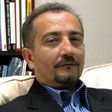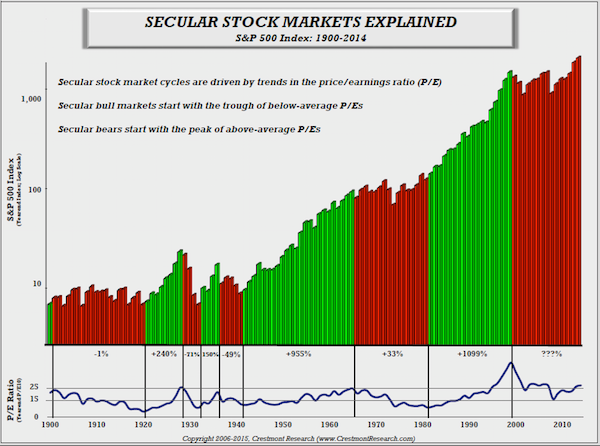Bear Market? I See a Bull Market for the Next 15-20 Years
Here’s what a long view of the direction of markets shows us.

The first week of 2016 started with a big move down in equity prices as a result of geopolitical events in emerging markets and fears of slowing economies worldwide. However, there are larger trends influencing markets today.
Understanding today’s market moves requires the study of market history and secular trends that dominate market direction. Most investors are unaware of secular bull and bear markets that control long-term direction of markets for significant periods of time.
Let’s review the last century of stock market cycles. Classifying bull markets and bear markets is necessary to understand their impact on short-term trends. I define secular bull markets as extended periods or years when the stock market achieves higher highs and higher lows, and bear markets retreat to lower highs and even lower lows. These extended bear and bull markets can last for eight to 20 years for either market. Take a look at this illustration of the S&P 500 for 114 years, with bull markets in green and bear markets in red:
From just $107.88 $24.99 for Kiplinger Personal Finance
Become a smarter, better informed investor. Subscribe from just $107.88 $24.99, plus get up to 4 Special Issues

Sign up for Kiplinger’s Free Newsletters
Profit and prosper with the best of expert advice on investing, taxes, retirement, personal finance and more - straight to your e-mail.
Profit and prosper with the best of expert advice - straight to your e-mail.

It is important to remember that the stock market is an auction system made up of millions of investors interacting electronically to achieve the best results for their efforts. People are emotional by nature, often influenced by both the fear of losing wealth and the greed of not attaining enough wealth; as a result, overbidding for desired stocks will push markets to much higher highs years before ending bull markets and beginning the bear markets that follow. There are, of course, other contributing factors, but most secular market trends are driven by the basic human emotions of fear and greed.
If you accept the existence of secular market trends, then the question is: where are we in 2016? To understand the answer to this question, let’s review the bear market that began in the year 2000. The bear market began in March 2000 after one of the greatest bull markets in history (1982-2000), giving investors a 1099% return if they invested in the S&P 500 for that period of time.
The bear market of 2000 began with the busting of the dot-com bubble and the S&P 500 falling in value until October 2002, with the final low reached in March 2003 before rising in value for the next four-and-a-half years until October 2007. The market fell again until March 2009 before starting its rise to current levels with the market highs reached in May 2015.
The S&P 500 did one extraordinary thing that did not happen during the prior 14 years of the secular bear market. In May 2013, it reached the highs achieved in the years 2000 and 2007, but, this time, it broke through the ceiling and has continued to rise to current (2016) levels. We at Geasphere believe that the breakout in 2013 was the end of the 14-year secular bear market and the beginning of the next secular bull market. (See illustration and explanation below of the 2000 secular bear market.)

The chart shows the beginning and the end of the secular bear market by illustrating the price action of the S&P 500 over the 14-year period. More importantly, it demonstrates the basic principal of economics: if you have more sellers than buyers in the market, markets will go down; the reverse is true that if you have more buyers than sellers in the market, it will go up. We believe the market has begun the next secular bull market that will last another 15 to 20 years.
We live in a time of the 24-hour news cycle, in which information that used to be interesting only to professionals is now packaged and highlighted with great graphics and music to investors with sensational entertainment values-- and yes, this might make good television, but it does not make good investors.
Enjoy the ride, because it’s going to be a long one.
Eduard Hamamjian, an accredited Asset Management Specialist, has been in the industry since 1992. With years of experience in investment research, portfolio construction and even business ownership, he has developed a suite of services specific to business owners.
Profit and prosper with the best of Kiplinger's advice on investing, taxes, retirement, personal finance and much more. Delivered daily. Enter your email in the box and click Sign Me Up.

As an Accredited Asset Management Specialist, Eduard has developed his investment approach through a unique diversification method, and proprietary stock valuation and various other strategies for research, construction and management of portfolios. Eduard's innovative strategies allow him to provide distinct value for GeaSphere clients looking for growth without excessive risk. He oversees the construction, research and management of client portfolios. In recent years, he has combined his investment approach with practical planning tools and cash flow solutions, so that he can deliver comprehensive services for business owners. He also partners with accounting firms for a simpler, more tax-efficient process for each client.
-
 Why Playing It Safe in Retirement Is a Big Risk
Why Playing It Safe in Retirement Is a Big RiskFear of losing money could actually cost you in retirement. Find out why being too conservative with your life savings can hurt you and how to stop that from happening.
-
 Tax Refund Alert: House GOP Predicts 'Average' $1,000 Payouts in 2026
Tax Refund Alert: House GOP Predicts 'Average' $1,000 Payouts in 2026Tax Refunds Here's how the IRS tax refund outlook for 2026 is changing and what steps you can take now to prepare.
-
 What Not to Do in an Airport Lounge
What Not to Do in an Airport LoungeBefore you settle into that cushy lounge chair, skip the rookie moves that annoy other travelers and can even get you kicked out.
-
 Meet the World's Unluckiest — Not to Mention Entitled — Porch Pirate
Meet the World's Unluckiest — Not to Mention Entitled — Porch PirateThis teen swiped a booby-trapped package that showered him with glitter, and then he hurt his wrist while fleeing. This is why no lawyer will represent him.
-
 Smart Business: How Community Engagement Can Help Fuel Growth
Smart Business: How Community Engagement Can Help Fuel GrowthAs a financial professional, you can strengthen your brand while making a difference in your community. See how these pros turned community spirit into growth.
-
 In 2026, the Human Touch Will Be the Differentiator for Financial Advisers
In 2026, the Human Touch Will Be the Differentiator for Financial AdvisersAdvisers who leverage innovative technology to streamline tasks and combat a talent shortage can then prioritize the irreplaceable human touch and empathy.
-
 How Financial Advisers Can Deliver a True Family Office Experience
How Financial Advisers Can Deliver a True Family Office ExperienceThe family office model is no longer just for the ultra-wealthy. Advisory firms will need to ensure they have the talent and the tech to serve their clients.
-
 Stocks Slip to Start Fed Week: Stock Market Today
Stocks Slip to Start Fed Week: Stock Market TodayWhile a rate cut is widely expected this week, uncertainty is building around the Fed's future plans for monetary policy.
-
 Why Investors Shouldn't Romanticize Bitcoin, From a Financial Planner
Why Investors Shouldn't Romanticize Bitcoin, From a Financial PlannerInvestors should treat bitcoin as the high-risk asset it is. A look at the data indicates a small portfolio allocation for most investors would be the safest.
-
 I'm a Financial Pro Focused on Federal Benefits: These Are the 2 Questions I Answer a Lot
I'm a Financial Pro Focused on Federal Benefits: These Are the 2 Questions I Answer a LotMany federal employees ask about rolling a TSP into an IRA and parsing options for survivor benefits, both especially critical topics.
-
 Private Credit Can Be a Resilient Income Strategy for a Volatile Market: A Guide for Financial Advisers
Private Credit Can Be a Resilient Income Strategy for a Volatile Market: A Guide for Financial AdvisersAdvisers are increasingly turning to private credit such as asset-based and real estate lending for elevated yields and protection backed by tangible assets.